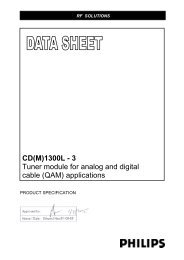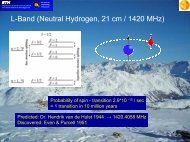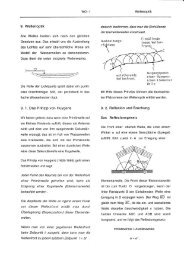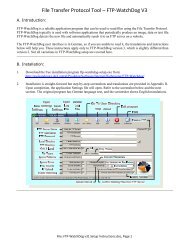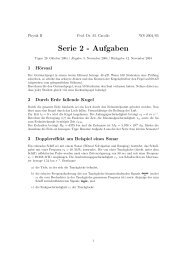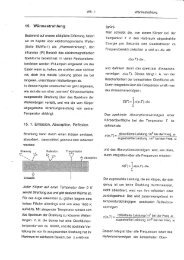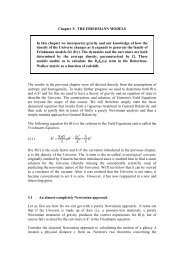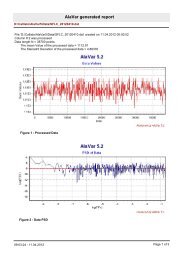here - Institute for Astronomy Umleitung
here - Institute for Astronomy Umleitung
here - Institute for Astronomy Umleitung
You also want an ePaper? Increase the reach of your titles
YUMPU automatically turns print PDFs into web optimized ePapers that Google loves.
Title: Science Case<br />
Reference: MUSE-MEM-SCI-052<br />
Issue: 1.3<br />
Date: 04/02/2004<br />
Page: 92/100<br />
- The asteroids orbiting the sun within the main belt have perihelion distances ranging<br />
between 1.6 and 3.3 a.u.. The possible spatial resolutions, assuming an angular<br />
resolution of 0.025", would thus range from 10 to 40 km/pixel.<br />
- For the largest objects (more than 10), it permits the mapping of the optical and<br />
mineralogical surface heterogeneities and consequently provides insight into their<br />
accretional and subsequent geochemical differentiation history. As an example, taking<br />
advantage of its rotation, MUSE could produce a global map of Ceres (diameter: 1025<br />
km).<br />
5.4. Temporal changes in Jupiter, Saturn, Uranus and<br />
Neptune<br />
The predicted spatial resolution delivered by MUSE in the high-resolution mode<br />
(corresponding to a 0.025" angular resolution) translates into effective physical scales as<br />
follows: 75 km/pixel at the distance of Jupiter, 150 km at Saturn, 300 km at Uranus and 500<br />
km at Neptune. The latter two objects represent the best candidates <strong>for</strong> both a synoptic survey<br />
and a truly new return in terms of scientific knowledge. Furthermore, their apparent diameters<br />
of about 4" and 2.3", respectively, make them ideal <strong>for</strong> global monitoring given the field of<br />
view of MUSE in its high spatial resolution mode. For Jupiter and Saturn, a global monitoring<br />
would be more time-consuming, requiring mosaics of several high-resolution fields. Instead,<br />
it may be more practical <strong>for</strong> these objects to target regional areas of interest (e.g. the red spot,<br />
polar regions, etc.).<br />
The key contribution of MUSE would be to monitor through time the mesoscale changes in<br />
the atmospheric patterns with the possibility of probing the 3-D atmospheric structure by<br />
examining different spectral windows along the extensive MUSE wavelength range,<br />
depending on the considered spectroscopic absorptions related to gaseous species such as:<br />
CO, C2H2, NH3, HC3N, CH4, etc. (e.g., Tomasko et al., 1984; West et al., 1986). For<br />
instance, in the case of the atmosp<strong>here</strong>s of Uranus and Neptune, photons in the 4900-6600 Å<br />
wavelength range penetrate to the deep convectively mixed atmospheric layers, giving<br />
in<strong>for</strong>mation on the deep methane abundance and aerosols properties (Moreno, et al., 1986).<br />
References:<br />
Caldwell, J., C.C., Cunningham et al. (1992). Titan: Evidence <strong>for</strong> seasonal change- A<br />
comparison of Hubble Space Telescope and Voyager images, Icarus, 96, 1-9.<br />
Combes, M., L. Vapillon, E. Gendron, A. Coustenis, O. Lai, R. Wittemberg, and R.<br />
Sirdey.(1997). Spatially Resolved Images of Titan by Means of Adaptive Optics, Icarus, 129,<br />
482-497<br />
Coustenis,A., E. Lellouch, J. P. Maillard, and C. P. McKay. (1995).Titan's surface:<br />
composition and variability from the near-infrared albedo, Icarus, 118, 87-104.<br />
Doute, S., B. Schmitt, R. Lopes-Gautier, R. Carlson, L. Soderblom, J. Shirley and the Galileo<br />
NIMS Team 2001, Mapping SO2 frost on Io by the modeling of NIMS hyperspectral images.<br />
Icarus 149, 107–132.<br />
Geissler, P., A. McEwen, C. Phillips, D. Simonelli, R.M.C. Lopes, and S. Douté (2001).<br />
Galileo Imaging of SO2 frosts on Io, J.geophys. Res., 106, E12, 33253-266.




